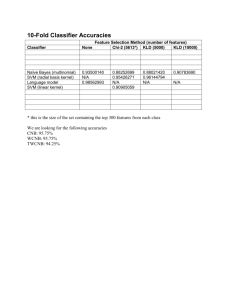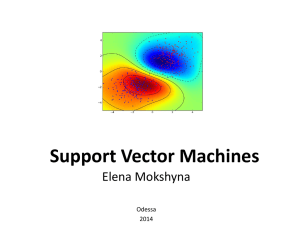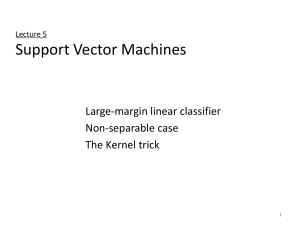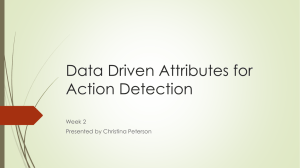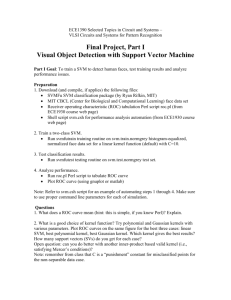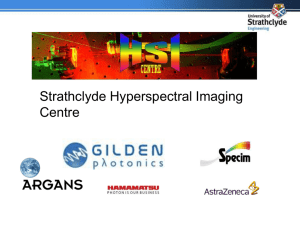Slide 1
advertisement
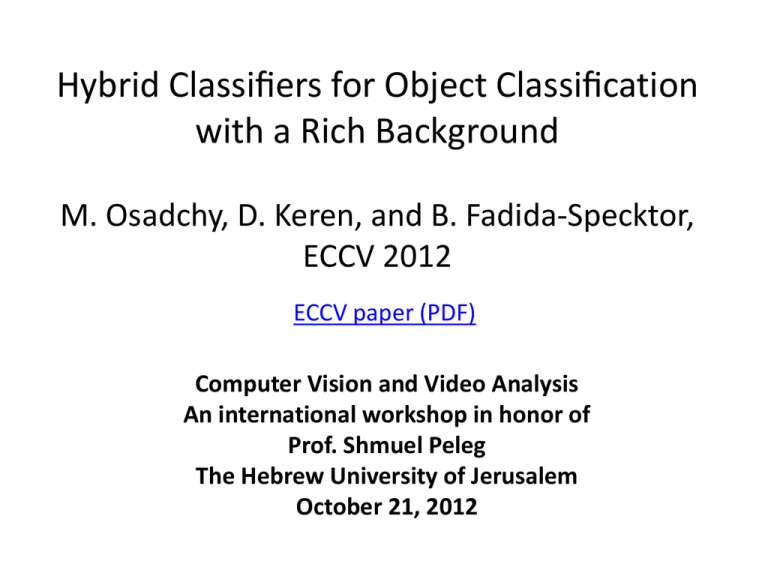
Hybrid Classifiers for Object Classification with a Rich Background M. Osadchy, D. Keren, and B. Fadida-Specktor, ECCV 2012 ECCV paper (PDF) Computer Vision and Video Analysis An international workshop in honor of Prof. Shmuel Peleg The Hebrew University of Jerusalem October 21, 2012 In a nutshell… • One-against-all classification. • Positive class = cars, negative class = all non-cars (= background). • SVM etc. requires samples from both classes (and one-class SVM is too simple to work here). • Hard to sample from the (huge) background. Proposed solution: • Represent background by a distribution. • Construct a “hybrid” classifier, separating positive samples from background distribution. Classes Diversity in Natural Images Previous Work 1. Cost sensitive methods (e.g. Weighted SVM). 2. Undersampling the majority class. 3. Oversampling the minority class. 4. … Alas, these methods do not solve the complexity issue. • • • • • Linear SVM (Joachims, 2006) PEGASOS (Shalev-Shwartz et al, 2007) Kernel Matrix approximation (Keerthi et al ,2006; Joachims et al, 2009) Special kernel forms: (Maji et al, 2008; Perronnin et al 2010) Discriminative Decorrelation for Clustering and Classification (Hariharan et al, 2012). M. Osadchy & D. Keren (CVPR 2006) Object class Instead of minimizing the number of background samples: minimize the overall probability volume of the background prior in the acceptance region. Background ≈ All Natural Images No negative samples! Less constraints in the optimization No negative SVs Background is modeled just once, very useful if you want many oneagainst-all classifiers. M.Osadchy & D. Keren (CVPR 2006) , cont. “Hybrid SVM”: positive samples, negative prior. 1) min Pr( natural images) 2 ) positive samples H 3) wide margin H H M.Osadchy & D. Keren (CVPR 2006) , cont. Problem formulation min w w ,b s .t . 2 C i 1 i M w x i b 1 i , i 1 .. M i 0 , i 1 .. M erfc 2 -b n i 1 2 wi di • “Boltzmann” prior: characterizes grey level features. Gaussian smoothness-based probability. • ONE constraint on the probability, instead of many constraints on negative samples. Expression for the probability that w x b 0 for a natural image x , vector w, and scalar b. Contributions of Current Work Work with SIFT. Kernelize. Kernel hybrid classifier, which is more efficient than kernel SVM, without compromising accuracy. • To separate the positive samples from the background, we must first model the background. • Problem – background distribution is known to be extremely complicated. • BUT – classification is done post-projection! How do projections of natural images look like? Under certain independence conditions, low dimensional projections of high-dimensional data are close to Gaussian. Experiments show that SIFT BOW projections are Gaussian-like: Histogram Intersection kernel of Sift Bow Projections Linear Classifier - Probability Constraint Using the Gaussian approximation, we obtain the following, for a natural image x, vector w, and scalar b: ( ) constraint Where 𝑥 is the mean and Σ𝑥 the covariance matrix of the background, and a small constant. shows a good correspondence with reality. ( ) Hybrid Kernel Classifier Probability constraint: same idea. Pr( 𝑙𝑖=1 𝛼𝑖 𝐾(𝑠𝑖 , 𝑥) ≥ 𝑏) ≤ 𝛿 where 𝛼𝑖 , 𝑠𝑖 , and b are the model parameters. The 𝑠𝑖′ 𝑠 are chosen from a set of unlabeled training examples. Define random variable 𝑧 = [𝑧1 , … 𝑧𝑙 ]𝑇 , where 𝑧𝑖 ≡ 𝐾 𝑠𝑖 , 𝑥 𝑖 = 1, … , 𝑙 . The constraint is then: 𝑷𝒓( 𝒍𝒊=𝟏 𝜶𝒊 𝒛𝒊 ≥ 𝒃) ≤ 𝜹 • In feature space, we cannot use the original coordinates. Must use some collection of coordinates 𝐾 𝑠𝑖 , 𝑥 . • Choose 𝑠𝑖 such that 𝐾 𝑠𝑖 , 𝑥 approximately span the space of all functions 𝑥 → 𝐾 𝑠, 𝑥 . Experiments Predict absence/presence of a specific class in the test image. Caltech256 dataset SIFT BoW with 1000 , SPM kernel. Performance of linear and kernel Hybrid Classifiers was compared to linear and kernel SVMs and their weighted versions 30 positive samples, 1280 samples for Covariance matrix + mean estimation. In SVM: 7650 samples EER for binary classification was computed with 25 samples from each class. Results SVM Weighted SVM Hybrid Linear 71% 73.9% 73.8% Kernel 83.4% 83.6% 84% Weighted SVM Hybrid 600-1000 230 Number of parameters in optimization 7680 230 Number of constraints in optimization 7680 31 Memory usage 450M 4.5M Number of kernel evaluations

